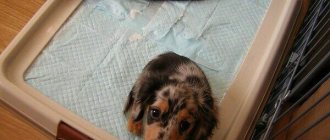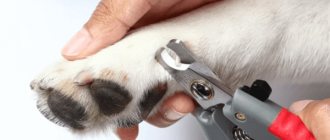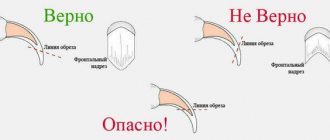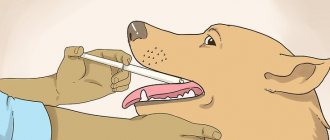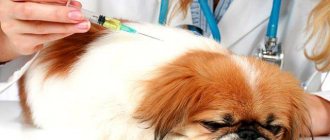The best food for a newborn puppy is its mother's milk. In addition to nutrients, it contains a huge amount of antibodies that babies need to protect themselves from illness. But time passes, they grow quickly, and mother’s milk becomes not enough. Usually the bitch feeds them for up to 1.5-2 months. But puppies need to introduce complementary foods much earlier, from about the third week of life.
At what age can you start feeding puppies complementary foods?
In general, experts recommend starting feeding puppies at one month of age.
But this is true if the lactating bitch has enough milk. If this is a small dog, for example, a Yorkie, and there are many puppies, then there will be little milk. Then the breeder will have to intervene when the babies are about 20 days old. Fact! The average fat content of dog milk is 9.5%, while that of cows is only 3.3%.
It is best to start feeding puppies with milk from three weeks of age. Ideally, take goat, as it is fattier. If this is not possible, you can use regular cow milk. For nutritional value, you can add one beaten quail egg per glass.
Basic knowledge
The average fat content of a bitch's milk is 9-10%. The substitutes you choose should have exactly the same fat content or slightly less. Often, owners make a common mistake and start feeding their puppies too early. Often this is not necessary. If the puppies sleep most of the time and gain weight normally, then everything is fine and there is no need to get up at night with the intention of bottle-feeding them. Don't forget that a bitch produces as much milk as her puppies drink. That is, with supplementary feeding you will stimulate a decrease in its amount.
How to wean puppies off their mother's milk
The bitch actively feeds the babies up to six to eight weeks of age. Then the amount of milk begins to decrease, so the puppies simply have no choice but to switch to the food provided by the owner. Well, he should know not only when to start feeding the puppies, but also how to do it correctly.
What and how to give puppies after one month of age
When the puppy turns one month old, it’s time to introduce him to solid food. Moreover, this applies to dogs, regardless of age - even a tiny pug, a miniature Spitz, or a fairly large Labrador or German shepherd. It is necessary to feed the puppies so that they receive enough nutrients, because there is no longer enough mother's milk for everyone.
To begin with, it is best to use lean meat (chicken, rabbit, veal), finely chopped or minced. You can also use cottage cheese (but not the cheap cottage cheese product). Some breeders add eggs to the cottage cheese from the first feedings - one quail per 200 grams or one chicken per 700 grams.
Healthy! It is advisable to wash eggs before eating to reduce the risk of poisoning or parasite infection.
Company always tastes better
What should be the portion size for a puppy?
Of course, the breeder must know when to feed the puppies and how much food to give. But this question is quite complex - it is simply impossible to give a universal scheme for months and weeks. Primarily due to the size of the dog. It is quite clear that a Chihuahua puppy and an Alabai puppy at the same age need different children's portions.
Features of feeding small, medium, large breeds
In general, experts believe that a puppy under the age of six months should eat an amount of natural food equal to 7% of its own weight. Moreover, this applies equally to small Yorkshire terriers and agile huskies or lazy Caucasian shepherd dogs.
True, there are certain nuances depending on the size. For example, small dogs aged two months need to be fed six times a day. But larger puppies prefer to eat more, but less often - it is better for them to be given food five times a day.
Note! It is important to monitor your puppy's behavior. Often you can tell from it whether he has enough food, too much or not enough.
Treats
Of course, you will pamper your beloved little dog with various treats and treats.
Do not forget that all treats offered to the puppy must be taken into account as part of the daily portion of food. The volume of treats should not exceed 5% of the daily protein intake.
It is best to offer natural, homemade treats as treats. They are easy to prepare and do not contain any preservatives or harmful substances. See the “Nutrition” section of our blog. There you will find many different recipes for homemade treats for dogs.
How to create a diet from natural food
As mentioned above, at the age of 2 months the diet should be based on cottage cheese, meat and eggs. Already at the age of 3 months, it can be enriched with porridges - they are prepared in water or meat broth. Millet, buckwheat and oatmeal are suitable. After another month, you can add some vitamins to the porridge - chopped carrots, zucchini and pumpkin. On such a diet, a puppy can live comfortably for up to six months or a year, and then its diet gradually transforms into the diet of an adult dog.
The number of feedings per day and how to understand whether the puppy is hungry or full
The number of meals per day depends on age. Experts consider the following system optimal:
- at 2-3 months – 5-6 times;
- from 3 to 4 months – 4-5 times;
- from 4 to 6 months – 3-4 times;
- from 6 to 10 – 3 times;
- from 10 months and older – 2 times.
It is very important to monitor what behavior the puppy demonstrates. If he carefully licks the cup, whines and does not move away from the feeding place, then the portion needs to be increased by 5-10%. If he doesn’t finish everything, leaving some in the bowl, then too much food is given - the diet should be reduced.
Meat is the basis of dog nutrition
Temperature
Healthy newborn puppies sleep most of the time (up to 90%) during the first three weeks, and spend the rest of the time eating. Body temperature until the 20th day is about 36.5-38 °C . During this period, the puppy must be provided with a constant, comfortable temperature regime, since he cannot independently maintain body temperature , even in a blanket.
If the puppy's body temperature is below normal, this is hypothermia. In this case, you must immediately warm it up by placing it on your body (under your jacket) . This is a long process: if the body temperature is 35 degrees, then warming up will take from 2 to 3 hours!
Under no circumstances should you warm up hypothermic puppies quickly (with a heating pad and especially on a radiator)! By doing this, you will only deprive the baby of his last strength and provoke unnecessary vasodilation.
A chilled puppy should not be fed either mother's milk or artificial food, since the stomach and small intestines will not be able to cope with the load in this case. During the warming process, he is given a 10% glucose solution with water (3.5 ml per 100 g of body weight) once an hour. Instead of glucose, you can use a solution of honey, or, in extreme cases, sweetened water: 3/4 teaspoon per 100 ml of water.
To accommodate newborns, it is necessary to organize a “nest”. It can be a box, the volume of which is sufficient to comfortably accommodate the puppies. Disposable diapers or cotton cloth can provide additional warmth and dryness. They need to be changed when they become dirty. The optimal temperature in the nest is +37. You can use an electric heating pad with a thermostat, warm water bottles, or a medical rubber heating pad.
Important : after 7 days from birth, puppies need to cut their claws and repeat the procedure every week. This process must be done as carefully as possible so as not to touch the nerve endings.
You can and should only trim the curved tip of the claw, no more than 1 mm!
Don’t be alarmed that the puppies only eat and sleep: this is necessary, because they are growing! Babies will open their eyes between 11-15 days of life, and will begin to hear on the 18th day.
Using vitamins in puppy food
Experienced breeders know how important vitamins are for a growing body, so they do not forget to add them to the food at the age of 2 months. The easiest way to purchase it is at the Trivit pharmacy. This is a mixture of vitamins A, E and D3 - the most important for dogs.
In addition, if you have to work with a large dog, you can add to the diet not only fermented milk products, but also preparations containing calcium - chalk or calcium gluconate. If this is not done, the grown pet may have problems with the musculoskeletal system.
Second month of life
The beginning of complementary feeding for puppies marks a new stage in the lives of babies. Now they are less and less dependent on their mother and spend more and more time exploring the world around them. Starting from week 5, additional foods can be introduced into the diet, one every three days. It is very important to prioritize the range of meats. Veal is a choice for first feeding, but not the only one. The only limitation is fatty pork, as well as pieces of lamb with tail fat. By the way, fatty chicken is also prohibited; you need to choose a young bird or remove excess fat.
At this age, milk ceases to play a primary role in the lives of babies. Now it is gradually being replaced by fermented milk products. It is best to prepare them for puppies yourself. In this case, you can be confident in the quality of the finished product. At the same time, raw calcined foods are better absorbed, so you should give them preference.
The first foods for puppies are an introduction to basic foods. Therefore, take into account the tender stomachs of babies and give them food in small portions. This will avoid stomach problems, bloating and diarrhea. Like a small child, a puppy’s gastrointestinal tract is still imperfect.
What can happen if you feed your puppy incorrectly?
Alas, not all breeders know what to feed puppies at 3 weeks and later. As a result, they commit many serious violations that can cause serious harm to the pet.
For example, if feeding is insufficient or unbalanced, the puppy will simply grow slowly, and various diseases may develop that affect the skeleton, sensory organs, and internal organs. Well, with excess feeding, on the contrary, the puppy begins not only to grow, but also to gain excess weight. Because of this, the puppy's fragile heart begins to work too intensely, and this is fraught with heart failure and death at a young age.
So, moderation and a balanced diet is the key to the normal development and good health of the dog.
How to teach a puppy to eat from a bowl
The procedure is quite simple. Often, puppies, attracted by the tasty smell, eat from the bowl themselves. If this does not happen, you can lightly poke your pet’s nose into the treat - he will be forced to lick his nose and lips, feel the taste of the food and start eating.
On a note! When feeding natural food, you need to make sure that the cup (especially if a metal one is used) is not hot - if it gets burned, the puppy will retain a dislike for the bowl for the rest of its life.
At this stage, it is important not to scare your pet. Otherwise, he will simply be afraid to eat from a cup, and this will cause a lot of problems for the owner.
You can't yawn in a big family
Understanding all the intricacies of feeding a puppy is not that difficult. Therefore, nothing will prevent you from providing your pet with tasty and healthy food from the first weeks of life.

